
Baba ghanoush, also spelled baba ganoush or baba ghanouj, is a Levantine appetizer consisting of finely chopped roasted eggplant, olive oil, lemon juice, various seasonings, and tahini. The aubergine is traditionally baked or broiled over an open flame before peeling, so that the pulp is soft and has a smoky taste. It is a typical meze ('starter') of the regional cuisine, often served as a side to a main meal and as a dip for pita bread.

Tabbouleh, also transcribed tabouleh, tabbouli, tabouli, or taboulah, is a Levantine salad made mostly of finely chopped parsley, with tomatoes, mint, onion, soaked uncooked bulgur, and seasoned with olive oil, lemon juice, salt and sweet pepper. Some variations add lettuce, or use semolina instead of bulgur.

Arab cuisine is the cuisine of the Arab world, defined as the various regional cuisines of the Arab people, spanning from the Maghreb to the Mashriq. These cuisines are centuries old and reflect the culture of trading in ingredients, spices, herbs, and commodities. The regions have many similarities, but also unique traditions. They have also been influenced by climate, cultivation, and mutual commerce.

Ful medames, or simply fūl, is a stew of cooked fava beans served with olive oil, cumin, and optionally with chopped parsley, garlic, onion, lemon juice, chili pepper and other vegetables, herbs, and spices. Ful medames is traditionally made in and served out of a large metal jug. It is notably a staple food in Egypt and is considered a national dish, especially in the northern cities of Cairo and Gizah. Fava beans can sometimes be also found in other cuisines in the Middle East, and Africa, though cooked differently.

Levantine cuisine is the traditional cuisine of the Levant, in the sense of the rough area of former Ottoman Syria. The cuisine has similarities with Egyptian cuisine, North African cuisine and Ottoman cuisine. It is particularly known for its meze spreads of hot and cold dishes, most notably among them ful medames, hummus, tabbouleh and baba ghanoush, accompanied by bread.
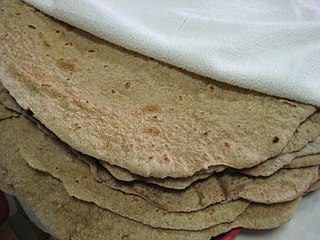
Markook bread, also known as khubz ruqaq, shrak, khubz rqeeq, mashrooh, and saj bread, is a kind of Middle Eastern unleavened flatbread common in the Levant and the Arabian peninsula. It is baked on a convex metal griddle or in a tannour.

Sahawiqzhoug or zhug is a hot sauce originating in Yemeni cuisine. In other countries of the Arabian Peninsula it is also called mabooj.

Palestinian cuisine consists of foods from or commonly eaten by Palestinians, whether in Palestine, Israel, Jordan, or refugee camps in nearby countries, or by the Palestinian diaspora. The cuisine is a diffusion of the cultures of civilizations that settled in the region of Palestine, particularly during and after the Islamic era beginning with the Arab Ummayad conquest, then the eventual Persian-influenced Abbasids and ending with the strong influences of Turkish cuisine, resulting from the coming of the Ottoman Turks. It is similar to other Levantine cuisines, including Lebanese, Syrian and Jordanian.

Israeli cuisine primarily comprises dishes brought from the Jewish diaspora, and has more recently been defined by the development of a notable fusion cuisine characterized by the mixing of Jewish cuisine and Arab cuisine. It also blends together the culinary traditions of the various diaspora groups, namely those of Middle Eastern Jews with roots in Southwest Asia and North Africa, Sephardi Jews from Iberia, and Ashkenazi Jews from Central and Eastern Europe.

Many cuisines feature eggplant salads and appetizers.

Middle Eastern cuisine or West Asian cuisine includes a number of cuisines from the Middle East. Common ingredients include olives and olive oil, pitas, honey, sesame seeds, dates, sumac, chickpeas, mint, rice and parsley, and popular dishes include kebabs, dolmas, falafel, baklava, yogurt, doner kebab, shawarma and mulukhiyah.

Bulgur, or burghul, is a cracked wheat foodstuff found in West Asian cuisine.

Masmouta salad is an Arab salad, served with bread and consisted mainly of potatoes, carrots, peas, green gourd and beets as per choice.
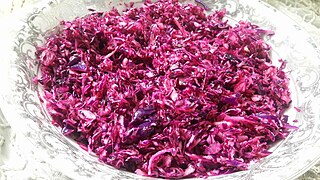
Malfouf salad or cabbage salad, is a Lebanese salad, typically consisting of shredded cabbage, lemon juice, olive oil, garlic, salt and dried mint.
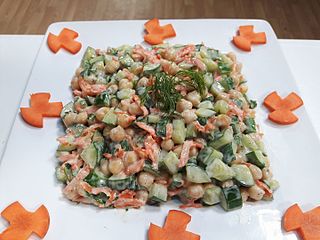
Chickpea salad, sometimes called hummus salad, using the Arabic word for 'chickpea', is a salad in Arab cuisine. It consists of whole cooked chickpeas, lemon juice, garlic, tahini, salt, olive oil, and cumin.
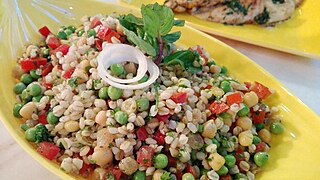
Wheat salad, is an Arab salad which typically consists of wheat, corn, tomatoes, carrots, cucumber pickles, lemon, parsley, olive oil and salt.
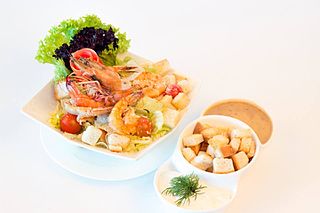
Rubiyan salad, is a type of Arab salad, typically made of shrimp, tomato. mayonnaise, lettuce leaves, ketchup, hot sauce, mustard, lemon juice, and salt.

Mutabbaq Samak a rice-based dish popular in the Arab states of the Persian Gulf and in some southern cities in Iraq. It is basically spiced fried fish, usually Stromateus and caramelized onions served over rice that is cooked in well-spiced fish stock. Fish can be whole fish or fish filet. It is considered a national dish in Iraq and Kuwait where the dish is pronounced in both of their colloquial dialects as "im'tabbag simach". In Arabia, raisins, cardamom and tomato broth are added too.
































